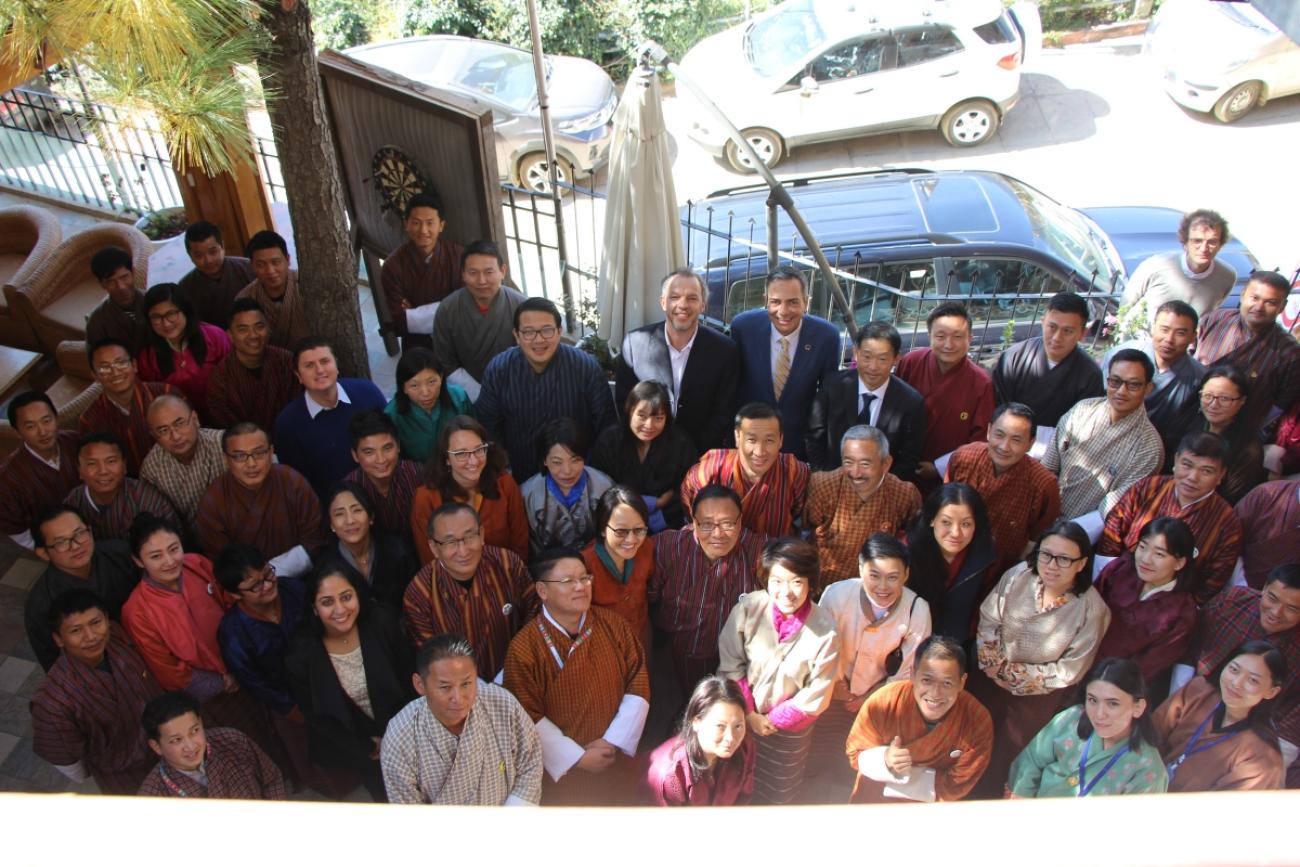Reforming Bhutan's civil service: Towards a future ready government

Blog by Azusa Kubota, UNDP Resident Representative and Tshoki Zangmo, Head of Exploration, UNDP Bhutan Accelerator Lab.
Scientists have long warned that the world was due for a major pandemic. The failure may have been on our part in not developing the required capacities to foresee, prepare, and adjust in time to an emerging threat. While the pandemic caused delays in the implementation of government’s plans and projects, the situation also pushed the government to revisit existing systems, forcing bureaucrats to be flexible, innovative, and quick in their decision-making.
In short, the COVID-19 crisis was a wake-up call for the civil service to embrace an approach that was anticipatory and not reactive in nature. His Majesty stressed the need for a reform in the civil service in his Royal address on Bhutan’s 113th National Day last month, bringing a renewed sense of urgency to this pressing need of the hour.
So, what kind of path should we adopt to reform civil service in the wake of a volatile, uncertain, complex, and ambiguous (VUCA) world? What forms of institutions, structures, capabilities, and incentives are needed to anticipate future disruptions, patterns, opportunities and challenges? How can we ensure that systems and processes are nimbler and more adaptive?
Anticipatory governance means different things to different people. For some , it is about envisioning, future forecasting, and scenario building in policy making and planning. For others, it is about accelerating learning loops by engaging citizens to input real-time data and feedback to make decision-making participatory. Well, what would anticipatory governance in the civil service look like?
For Bhutan, three learnings from the pandemic stand out:
1. Accelerated innovation and experimentation: A year ago, the civil service system was equipped with processes that require extended periods to establish partnerships, budget, and execute a plan. But ever since COVID-19 struck the country in March, the government began developing an experimental mindset. We saw public servants testing digital ideas at an accelerated rate to learn what works and what doesn’t. In a way, the pandemic became a catalyst for rapid innovation and experimentation in the public sector, and this trend must be nurtured and leapfrogged for Bhutan to keep up with the pace of change.
2. Embedded ‘next generation’ engagement platforms: The pandemic rather abruptly eliminated the traditional method of in-person citizen engagement. Almost overnight, there was an emergence of national hotlines and social media platforms, for the public to receive critical information on multiple services.
These e-engagement platforms provided a feedback loop for citizens to articulate their preferences, grievances, and other proposals that would help them better navigate and adapt to the fast-evolving pandemic. It allowed wider outreach and led to innovative decision-making by attracting diverse perspectives, all at a lower cost. As a result, it placed citizens at the core of an iterative designing process.
3. Focused on co-creation and co-production: We witnessed new alliances being formed to coordinate responses to the pandemic. Going out of traditional institutional silos, civil servants used or built networks to access ideas, and resources through new partnerships, cooperation and collaborations across agencies as well as with the private sector.
We observed an increase in the flexibility and mobility within public servants and across communities for redeployment to strengthen efforts to prevent the spread of coronavirus. The government enhanced data sharing to find new ways to coordinate responses, enabling discussions and decisions to take place at an unprecedented pace. These experiences have demonstrated the potential of the civil service to respond to ‘wicked’ challenges by co-creating within a broader ecosystem of partners to design and deliver services in an equal and reciprocal relationship.
Overall, the pandemic sparked innovation in civil services around the world, and certainly here in Bhutan. Hopefully some of these changes will outlive the immediate crisis as we begin to look towards the road of recovery. The COVID-19 crisis has also demonstrated that in times of difficulties, the public in general relies on the government to come to the rescue, reinforcing the need to future-proof the civil service.
So, what can be done? Here are some ideas that would help chart a post-COVID pathway for the civil service.
1. Build capabilities in foresights: The government’s ability to anticipate is directly linked to the capacities of the civil service in future thinking, foresight tools and practices. A cohort of civil servants who are curious, on a constant look out for signs of change, and strive towards continuous improvements is key. It is also essential to institutionalize the governance architecture to sustain regular and impactful foresight workshops across sectors.
A good case in point is the Centre for Strategic Futures established by the Singapore government. The Centre has been successful in integrating foresights in the public service’s consciousness, identifying key shifts and trends, stress testing current strategies and policies, building capabilities by developing common understanding and vocabulary around how the future could change. Perhaps, it’s about time that Bhutan has something like this in place. It would be worth establishing a Future’s Commission.
2. Enhance co-production of services: Conventionally, citizens are consulted only at some point. However, citizens could instead become a part of the conception and design of the services. The role of public servants could gradually transition to become facilitators for co-production of services. Tools and techniques of design thinking can be used to develop solutions with citizens to cater to their evolving needs. This may also entail adopting a more client-based service offer approach by considering empathy in public service education and training. In the end, what’s important is to view citizens as active partners and not passive customers waiting to consume services provided by the government.
The Swedish government, for example, provides platforms for citizens to engage in collective action, citizen participation, and co-production of many services. Likewise, Singapore initiated an idea sprint, calling on the public to contribute and co-create solutions to address the COVID-19 crisis.
3. Foster inter-agency collaboration: Civil servants will need to understand how the same problems can spill and interact across ministries and agencies. It is important to tap into these integrated networks of knowledge that offer access to low hanging fruits for integrated decision making.
Estonia's 'once-only' is a great example for institutionalizing inter-agency collaboration into structured routine settings. It mandates the state to re-use the information submitted by any citizen or business instead of asking for the same information again. This initiative has not only helped digitize services but also eased out the inter-agency boundaries.
Similarly, engaging in horizontal collaborations such as conducting interagency hackathons may also contribute to building trust. Such collaborations also require implementing the practice of coordinated leadership. This emerging leadership paradigm sometimes termed as distributed or adaptive leadership encourages leaders to direct their employees towards collaborative efforts to get results rather than solely limiting efforts within the agency. Leaders here are also aware of the limitations of their own innovation skills and rely on the expertise of their workforce. This model also requires shifts in accountability and reporting structures from the traditional vertical channel to a more horizontal one.
4. Improve service intelligence: We also live in a data age where every agency is generating huge amounts of data. But unless the data is structured and shared in real time at an accelerated pace, it might not be of any public value. For instance, decisions are made on statistics and publications that suffer from a substantial time lag.
What is required here is a common data center which carries out near real-time data processing and analysis to enhance decision making capabilities in planning and policymaking. It will also help break down data silos and ensure course corrections in real-time, by adapting and shaping to the changing needs and expectations of the citizens. Such digital spaces could be further expanded to include open-ended processes and synergist feedback loops enabling a real-time governance framework. In Taiwan, the vTaiwan platform provide an avenue to consult and collect information from citizens’ through digital conversations. It takes place in a multistep process involving coordinated dialogues between government, private sector and local communities.
Other prospective ideas include developing an innovation playbook for the civil servants. An interagency group could be convened to develop the toolkit consisting of creative tools and techniques such as citizen science, crowdsourcing and human centered design thinking among others. Nesta's playbook for innovation learning is a good resource.
Besides, the innovation guideline, the government could think of having provisions for a cross-sectoral innovation fund. A dedicated innovation fund might just provide the right condition to not only break silos but also instill a culture of innovation among the public servants. The government of Canada has a dedicated public sector innovation budget for each ministry and agency. Furthermore, it’s also equally important to create incentives to encourage civil servants to innovate. For instance, providing fast track promotions as a reward for those who are delivering results differently and better. Likewise, it is also crucial to provide a fail-safe environment as failure is a key element in the innovation journey. Creating such a space would mean asking civil servants to constantly question the status quo and to reflect, to experiment, to fail, and most importantly to learn.
Given the far-reaching impact of the civil service in driving services, they have a stake in ensuring that they are equipped with the right skills, incentives and an ecosystem to innovate. The COVID-19 crisis provides a once in generation opportunity to transform the civil service ecosystem, and to ensure fast, relevant and agile recovery pathways that are more inclusive, greener and sustainable in alignment with the ethos of a Gross National Happiness nation.
Written by


